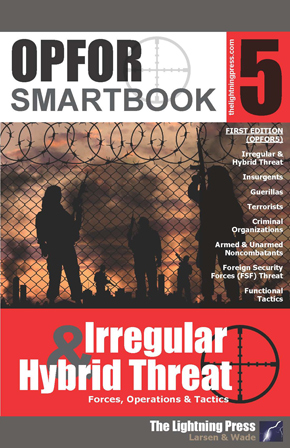A hybrid threat is the diverse and dynamic combination of regular forces, irregular forces, and/or criminal elements all unified to achieve mutually benefitting effects. The term “hybrid” has recently been used to capture the seemingly increased complexity of war, the multiplicity of actors involved, and the blurring between traditional categories of conflict. While the existence of innovative adversaries is not new, today’s hybrid approaches demand that U.S. forces prepare for a range of conflicts.
Irregular forces are armed individuals or groups who are not members of the regular armed forces, police, or other internal security forces.The irregular OPFOR can be part of the hybrid threat (HT). The irregular OPFOR component of the HT can be insurgents, guerrillas, or criminals or any combination thereof. The irregular OPFOR can also include other armed individuals or groups who are not members of a governing authority’s domestic law enforcement organizations or other internal security forces.
Irregular forces are unregulated and as a result act with no restrictions on violence or targets for violence. Time-honored concepts of “conventional” and “unconventional” war and “traditional” methods versus “adaptive” methods are weapons to a hybrid threat. One of the most significant capabilities of the irregular OPFOR is the ability to manipulate and/or ignore the restrictions and sanctions that apply to regulated military forces, law enforcement agencies, and internal security forces belonging to a sovereign state. The ability to combine and transition between regular and irregular forces and operations to capitalize on perceived vulnerabilities makes hybrid threats particularly effective.
OPFOR5 topics and chapters include irregular and hybrid threat (components, organizations, strategy, operations, tactics), insurgents and guerillas forces (characteristics, organizations, TTPs), terrorists (motivations, behaviors, organizations, operations and tactics), criminals (characteristics, organizations, activities), noncombatants (armed & unarmed), foreign security forces (FSF) threats, and functional tactics.
Download a free PDF sample and learn more at: OPFOR SMARTbook 5 – Irregular & Hybrid Threat (Forces, Operations & Tactics)
Insurgents are armed and/or unarmed individuals or groups who promote an agenda of subversion and violence that seeks to overthrow or force change of a governing authority.
A guerrilla force is a group of irregular, predominantly indigenous personnel organized along military lines to conduct military and paramilitary operations in enemy-held, hostile, or denied territory.
Terrorism is a tactic. Terrorism can be defined as the use of violence or threat of violence to instill fear and coerce governments or societies. Often motivated by philosophical or other ideological beliefs, objectives are typically political in nature.
Criminal elements exist at every level of society and in every operational environment (OE). Their presence, whatever their level of capabilities, adds to the complexity of any OE.
A host of noncombatants add complexity to any operational environment. Noncombatants are persons not actively participating in combat or actively supporting of any of the forces involved in combat. They can be either armed or unarmed. The irregular OPFOR attempts to manipulate these noncombatants in ways that support its goals and objectives.
Foreign security forces (FSF) are those forces, including, but not limited to military, paramilitary, police, and intelligence forces; border police, coast guard, and customs officials; and prison guards and correctional personnel, that provide security for a host nation and its relevant population or support a regional security organization’s mission. An FSF threat attack is a violent act perpetrated against a U.S. Service member, civilian, or contractor by a FSF member or members who have access to U.S. Service members, civilians, or contractors. The FSF threat is not a new phenomenon; however, during recent limited contingency operations, U.S. forces experienced a sharp increase in the number of attacks perpetrated by FSFs.
Insurgents and guerrillas, as part of the irregular OPFOR, may employ adaptive functional tactics. When planning a tactical action, an irregular OPFOR commander or leader determines what functions must be performed to accomplish the mission. Then he allocates functional responsibilities to his subordinates and synchronizes the effort.
Browse additional military doctrine articles in our SMARTnews Blog & Resource Center.
About The Lightning Press SMARTbooks. Recognized as a “whole of government” doctrinal reference standard by military, national security and government professionals around the world, SMARTbooks comprise a comprehensive professional library. SMARTbooks can be used as quick reference guides during operations, as study guides at education and professional development courses, and as lesson plans and checklists in support of training. Browse our collection of Military Reference SMARTbooks to learn more.















































